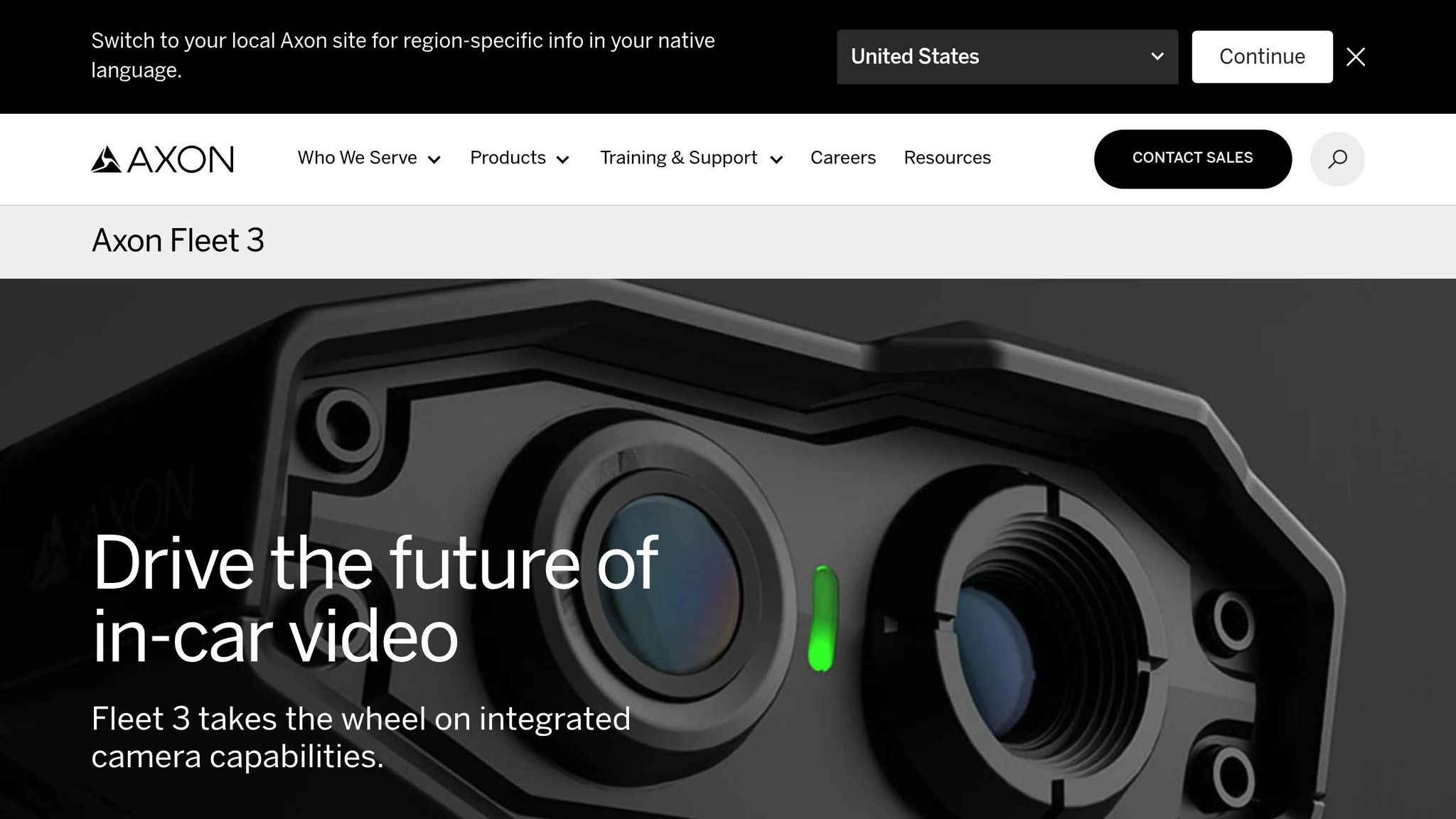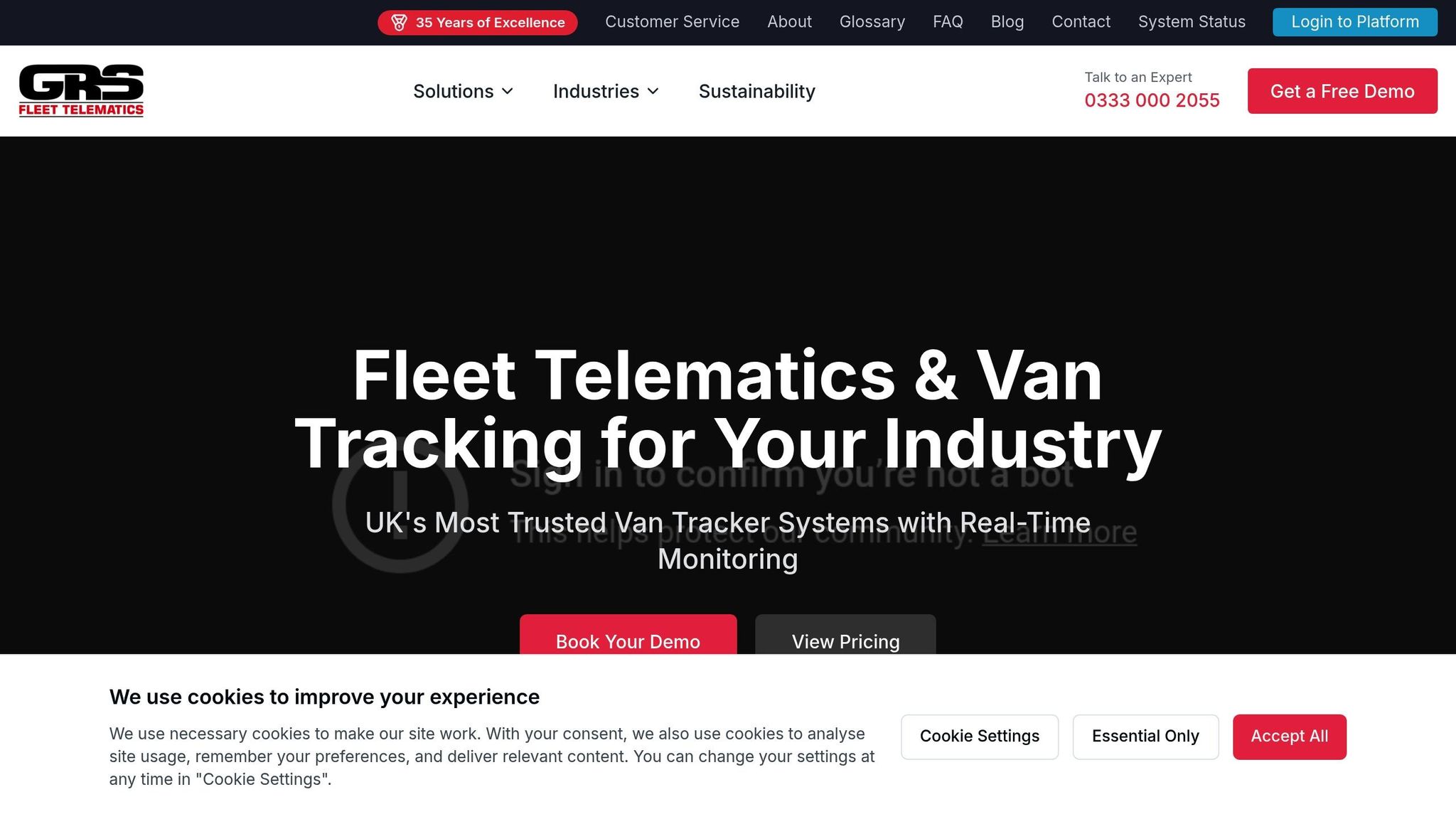Fleet modems are essential for connecting vehicles to central systems, allowing real-time data sharing that helps businesses in the UK improve efficiency, reduce costs, and meet regulations. These devices use cellular networks to transmit crucial information like location, speed, and diagnostics, enabling better management and security for fleet operations.
Key highlights:
- Real-time tracking: Monitors vehicle location, speed, and driver behaviour.
- Improved security: Alerts for theft and remote immobilisation options.
- Compliance support: Automates logs for maintenance and driver hours to meet UK regulations.
- Cost savings: Reduces fuel use by optimising routes and schedules.
- Reliable connectivity: Features like dual SIM support and satellite backup ensure uninterrupted data flow.
The right modem choice depends on factors like network compatibility, data security, and operational needs. Options include cellular, satellite, and hybrid modems, each suited for specific environments and budgets. Investing in modern modem technology offers a reliable way to manage fleets efficiently and protect assets.
Equipping Public Safety Vehicles with Axon Fleet 3 and Cradlepoint Wireless LTE and 5G Solutions

How Communication Modems Work in Fleet Systems
Communication modems play a key role in transforming raw vehicle data into actionable insights for fleet managers across the UK. Their operation is essential for delivering real-time information that helps improve fleet efficiency and decision-making.
Data Transmission Process
The process starts within the vehicle itself. Sensors monitor critical metrics like fuel consumption, engine performance, and fault codes, while GPS receivers track location data. This information is collected by the telematics control unit (TCU) - commonly referred to as the "black box" - which processes and organises the data for transmission.
Using a SIM card, the modem connects to UK mobile networks such as EE, Vodafone, O2, or Three. It transmits this aggregated data to cloud servers via 4G or 5G networks, with satellite backup available in remote areas where mobile coverage might be unreliable.
Modern modems also support two-way communication, allowing fleet managers to send commands back to vehicles. This enables features like remote diagnostics, geofencing alerts, and over-the-air software updates, ensuring constant monitoring and quick action when needed. Additionally, many modems can store data locally during network outages. Once the connection is restored, the modem syncs this stored data automatically - a vital feature for maintaining compliance and investigating incidents.
Real-Time Data Benefits
The immediate flow of data provided by these systems revolutionises fleet management. Real-time updates allow for tracking GPS location, vehicle speed, engine health, fuel use, and even driver behaviour. This instant access supports quicker decision-making and boosts operational efficiency.
For example, a London-based delivery van can send its location and engine status every minute, enabling managers to adjust routes promptly or respond to mechanical faults as they arise. In the case of theft or unauthorised vehicle movement, the modem sends instant alerts to the central platform, enabling swift coordination with authorities. GRS Fleet Telematics uses a dual-tracker system - combining a primary hardwired tracker with a hidden Bluetooth backup device - which has resulted in a 91% recovery rate for stolen vehicles.
Beyond location tracking, modems provide detailed diagnostics, such as engine temperature, brake wear, and emissions data. This allows fleet managers to receive alerts for predictive maintenance, minimising unexpected breakdowns and ensuring vehicles stay on the road.
Real-time data transmission also simplifies compliance with UK regulations. Automated records of driver hours, vehicle maintenance, and operational logs help businesses meet DVSA standards during inspections. This eliminates manual record-keeping errors and provides a reliable, auditable trail for fleet operations.
Lastly, with cybersecurity being a growing concern, advanced encryption and authentication measures are in place to protect sensitive data during transmission. These safeguards ensure that both business operations and customer information remain secure against evolving threats.
Fleet Modem Features and Benefits
Fleet modems play a vital role in ensuring seamless data transmission, but their advanced features take connectivity and performance to the next level. These devices now act as central hubs, offering solutions tailored to the unique needs of UK businesses.
Key Fleet Modem Features
Dual SIM support is a game-changer for maintaining uninterrupted connectivity. By housing two SIM cards from different network providers, these modems can switch between networks whenever one experiences poor coverage. Whether navigating the bustling streets of London or the remote Scottish Highlands, this feature ensures reliable communication across the UK's diverse terrain.
Failover connectivity works hand in hand with dual SIM support. If the primary network falters, the modem automatically switches to the backup SIM, keeping data flowing without a hitch. This seamless transition prevents disruptions in vehicle monitoring and fleet management, which could otherwise lead to costly inefficiencies.
Network compatibility is another crucial feature. Modern modems work effortlessly with leading UK networks like EE, Vodafone, O2, and Three. This flexibility allows fleet managers to mix and match networks to suit specific routes and operational demands.
Advanced encryption measures safeguard sensitive data during transmission. By implementing robust authentication systems, these modems protect critical information like vehicle locations, driver details, and operational data from unauthorised access.
Integration with vehicle diagnostics systems through OBD-II or CAN-BUS ports offers fleet managers detailed insights into vehicle performance. From engine diagnostics and fuel usage to maintenance alerts, these modems provide real-time data that helps optimise fleet operations.
Remote firmware updates ensure modems stay up to date with the latest features and security patches. This eliminates the need for physical access to vehicles, keeping connectivity systems efficient and secure throughout their use.
These features collectively enhance both the operational effectiveness and security of fleet management systems.
Benefits of Fleet Modems
The benefits of modern fleet modems go far beyond basic tracking. Real-time tracking combined with geofencing alerts gives fleet managers instant updates on unauthorised route deviations or access. Remote immobilisation adds an extra layer of security, allowing managers to disable a vehicle remotely in case of theft.
Some systems take security a step further with a dual-tracker setup, significantly improving recovery rates - an invaluable feature for UK businesses concerned about vehicle theft.
Operational efficiency is another standout advantage. With real-time data on vehicle locations, driver habits, and engine diagnostics, fleet managers can optimise routes, cut fuel consumption, and schedule proactive maintenance. For instance, identifying excessive idling or harsh braking helps managers implement targeted strategies to reduce costs and extend vehicle lifespans. Research shows that fleets using telematics can cut fuel expenses by up to 15% and maintenance costs by 10–20% through better monitoring and driver coaching.
Compliance support is also simplified. Fleet modems automatically log driving hours, track vehicle health, and store journey data to meet UK and EU regulations, such as tachograph rules and emissions standards. This automation reduces paperwork and helps businesses avoid penalties for non-compliance.
Modem Types Compared
Choosing the right type of fleet modem is key to meeting specific operational needs and budgets. Here's a breakdown of the main options available:
| Modem Type | Coverage in UK | Cost | Best For | Limitations |
|---|---|---|---|---|
| Cellular | Excellent (urban/suburban) | £ (low) | Urban fleets, highways | Limited in rural areas |
| Satellite | Nationwide, including remote areas | £££ (high) | Rural and remote operations | High cost, slower speeds |
| Hybrid | Universal (cellular + satellite) | ££ (medium) | High-value assets, critical operations | Higher initial investment |
Cellular modems are the most affordable and practical choice for fleets operating in cities, suburbs, and along major motorways. They provide excellent coverage where most commercial activity takes place. Satellite modems, on the other hand, are indispensable for businesses operating in rural or remote regions where cellular networks fall short. Finally, hybrid modems combine the strengths of both technologies, automatically switching between cellular and satellite to guarantee uninterrupted connectivity. These are ideal for businesses handling high-value assets or critical deliveries, where reliability is non-negotiable.
How to Choose the Right Fleet Modem
Picking the right fleet modem is a crucial step that ties directly into your fleet's operational success. A poor choice can lead to connectivity problems, security risks, and unnecessary expenses - all of which can hit your bottom line hard. Here's how to ensure you make the right decision.
Key Factors to Consider
When selecting a modem, network compatibility should be top of mind. The device needs to work seamlessly with major UK carriers like EE, Vodafone, O2, and Three. It’s also wise to choose a modem with fallback options for areas with limited 4G coverage. If your fleet operates across Europe, make sure the modem supports EU roaming to maintain connectivity during cross-border trips.
For uninterrupted service, especially in rural areas, choose a modem that supports both 4G LTE and 5G bands tailored for the UK market. This dual-band capability provides a safety net, ensuring your fleet stays connected even in challenging locations.
Data security is another critical consideration. Look for features like end-to-end encryption, secure boot processes, and compliance with GDPR regulations. The modem should also support secure authentication protocols and offer remote lock or wipe functions in case of theft. Regular firmware updates delivered over-the-air are essential for keeping security measures up to date.
Integration capabilities are vital for smooth operation with your existing systems. Ensure the modem supports common protocols such as CAN-BUS, OBD-II, and TCP/IP. Devices with open APIs or software development kits (SDKs) make it easier to customise integration with your current telematics setup. A consultation with both your modem supplier and telematics provider before purchase can help you avoid compatibility headaches.
Cost is not just about the upfront price. While the initial cost of a modem typically ranges from £50 to £200 per unit, you’ll also need to budget for installation and ongoing monthly subscriptions, which can range between £5 and £20 per vehicle, depending on data usage and features. Calculating the total cost of ownership over three to five years will give you a clearer picture of the long-term investment.
Lastly, hardware durability is essential for vehicles operating in the UK’s unpredictable weather. Look for ruggedised modems with weatherproofing, high-gain antennas, and a compact design for easier installation.
By considering these factors, you’ll ensure your modem aligns with your fleet’s current needs while also preparing for future challenges.
Preparing for the Future
To keep your fleet connected as technology evolves, invest in a 5G-capable modem with backward compatibility and over-the-air update capabilities. Confirm that your supplier offers a clear policy and schedule for updates to ensure your modem remains secure and functional.
Scalability is another important feature. Modems with memory units can store data during network outages, preventing information loss, while battery modules allow tracking to continue even when vehicles are powered off. This ensures your system can grow alongside your business without requiring a complete overhaul.
Look for modems with multi-interface capabilities, supporting Wi-Fi, cellular, and LTE. This flexibility makes it easier to adapt to changing operational demands. Additionally, devices with expandable functionality can accommodate new sensors or communication protocols as your fleet management needs evolve. Two-way communication capabilities are particularly useful, allowing data to flow to the cloud while enabling back-end systems to send commands to vehicles.
Choosing the right modem isn’t just a technical decision - it’s an investment in your fleet’s efficiency, security, and long-term success. By aligning your modem choice with operational needs, security requirements, and future demands, you’ll ensure seamless connectivity and a solution that serves your fleet well for years to come.
GRS Fleet Telematics: Advanced Connectivity Solutions

GRS Fleet Telematics highlights how cutting-edge connectivity can transform fleet operations, offering UK businesses reliable, real-time tracking powered by modem technology.
About GRS Fleet Telematics
Known for its dependable van tracking solutions, GRS Fleet Telematics employs a dual-tracker system to boost both security and reliability. Pricing begins at just £7.99 per month per vehicle, with hardware options available in three tiers: Essential (£35), Enhanced (£79), and Ultimate (£99). These tiers provide flexible options to suit various operational needs, all while enabling precise, real-time monitoring.
Fleet Connectivity Features
At the core of GRS Fleet Telematics' solutions is modem technology, which ensures live GPS tracking through robust cellular networks. This connectivity allows fleet managers to monitor vehicle location, speed, and status instantly via user-friendly web and mobile apps.
The system's design includes a primary tracker connected to the vehicle's power supply, providing continuous data transmission. If the primary system is ever compromised, a hidden Bluetooth backup takes over, ensuring uninterrupted connectivity.
Security features are a key highlight, offering tools like vehicle immobilisation and real-time theft alerts for rapid response. Additionally, the devices are compatible with multiple UK carrier networks, making them effective across various terrains. Geofencing capabilities add another layer of control, enabling managers to track when vehicles enter or leave specific zones.
To ensure seamless operation, professional technicians handle the installation, optimising antenna placement and securing power connections to prevent common issues. GRS Fleet Telematics also provides 24/7 support and emergency assistance to address connectivity problems quickly, reducing fleet downtime.
For businesses looking to customise their tracking systems, white-label branding options are available, allowing companies to present the platform under their own name.
Conclusion
Communication modems are the backbone of real-time data exchange between vehicles and central management systems in UK fleets. This seamless connectivity drives numerous operational and security improvements.
With modem-enabled connectivity, fleets can cut fuel costs by as much as 15% while enhancing driver safety through real-time monitoring of behaviours like harsh braking and speeding. These benefits highlight the practical advantages of investing in reliable fleet connectivity solutions.
When choosing a modem for your UK fleet, prioritise strong cellular network support to ensure consistent data transmission. It's also crucial to consider cybersecurity features to safeguard sensitive fleet data during communication. To stay ahead, opt for modems that are compatible with emerging network standards and scalable telematics platforms.
Cloud-based telematics takes fleet management to the next level by enabling real-time decision-making. Fleet managers can remotely access and analyse data from multiple vehicles, making operations more efficient and responsive. This shift towards advanced connectivity has transformed fleet management into a more streamlined, secure, and cost-effective process.
For UK businesses exploring fleet connectivity solutions, the technology now offers excellent value. The combination of dependable modem technology, detailed tracking features, and expert support services ensures smoother operations and improved vehicle security. As modem technology advances, these systems will continue to play a central role in delivering the performance gains and security measures essential for modern fleet management.
FAQs
How do fleet modems improve vehicle security and help prevent theft?
Fleet modems are a game-changer for vehicle security, offering advanced tracking and monitoring capabilities through telematics systems. By providing real-time location updates, they make it much easier to locate and recover stolen vehicles swiftly.
Take dual-tracker technology and instant theft alerts, for example. These features, available through GRS Fleet Telematics, have resulted in an impressive 91% recovery rate for stolen vehicles. This reliable solution not only strengthens security but also gives businesses managing vehicle fleets across the UK greater peace of mind.
What should businesses look for when choosing a modem for their fleet operations?
When selecting a modem for fleet operations, it's essential to focus on how well it works with your current telematics systems and whether it meets the specific needs of your vehicles. Strong security features are equally important, as they safeguard sensitive information and maintain dependable communication.
Other key considerations include how simple the modem is to install, its durability, and whether it can withstand the daily demands of your fleet. GRS Fleet Telematics offers advanced van tracking solutions with top-tier security, featuring dual-tracker technology and a proven record for recovering stolen vehicles. This makes it a trusted option for businesses throughout the UK.
How do fleet modems support UK compliance and boost efficiency for businesses?
Fleet modems play a crucial role in helping businesses adhere to UK regulations while boosting operational efficiency. Integrated into telematics systems, these devices allow for real-time tracking and detailed reporting on essential metrics such as fuel usage, vehicle maintenance, and driver behaviour. This not only helps companies meet legal standards but also streamlines day-to-day operations.
With features like route planning and driver performance analysis, fleet modems contribute to safer journeys and cost savings. The data they provide enables businesses to make smarter decisions, enhance productivity, and stay compliant with minimal hassle.

